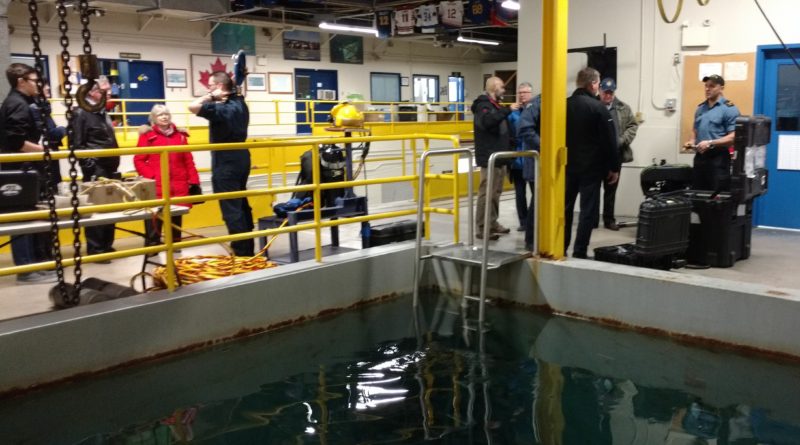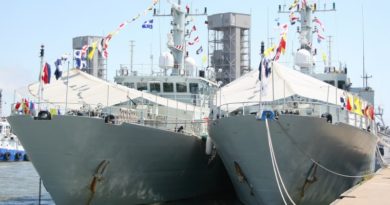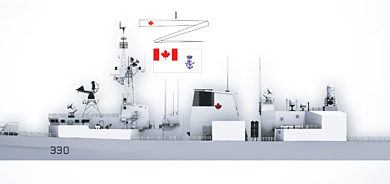A Tour of the Fleet Diving Unit (Atlantic)
On 15 February 2017, Fleet Diving Unit (Atlantic) [FDU(A)] hosted members of RUSI(NS), the RCMP Underwater Recovery Team and other assorted diver, military and community associations at the unit’s Shearwater facilities. The Commanding Officer, Lieutenant Commander William Barter, and the Operations Officer, Lieutenant(N) Joel Cormier, provided a comprehensive briefing to the gathering on the roles, responsibilities and activities of the unit. The brief was followed by an informative tour of their gear and equipment.
For the general public and even for the Royal Canadian Navy (RCN), FDU(A) tends to be a hidden dynamo in the rough. Located over with their Royal Canadian Air Force (RCAF) cousins at Shearwater close to the Yacht Club, the divers are removed from the attention and activity that takes place at Her Majesty’s Canadian (HMC) Dockyard Halifax. Infrequently, their jetty sees use if a Sea King helicopter requires hoisting from a ship’s deck or if a visiting foreign submarine needs to come alongside. Ships’ companies know the unit as the place to send their Ship’s Team Divers for training. Frigates engaged in force protection training frequently ‘fight’ off the unit’s fast attack craft when they are in the vicinity of the Maugher’s Beach lighthouse. Occasionally, the unit’s dive tender vessel can be seen transiting the Narrows en route to their demolitions site in Roach Cove up in Bedford Basin. But in the course of the briefing, the audience soon realized this tranquil exterior hid a bustling organization active in Canada and abroad.
At present, the unit has 111 Clearance Divers and support personnel with a mixture of officers, Non-Commissioned Members (NCM) and a few civilian administrative staff. The unit also continuously employs a substantial number of Reservists. During 2016, they deployed personnel to 15 locations worldwide, and this year plan on at least 11 deployments. Locally, they are constantly on call to use their specialized skills with Explosive Ordinance Disposal (EOD) responding to cases involving military Unexploded Ordinance (UXO). Their Area of Responsibility (AOR) includes the upper two thirds of Nova Scotia and all of Newfoundland and Labrador. As for discovered underwater UXO, they split the country in half at the MB/ON border with their sister unit FDU(P) in Esquimalt, BC. In addition, members can be called upon to conduct underwater engineering duties such as emergency bearing changes or hull repairs on deployed frigates. They are on standby in case of a submarine search and rescue (SUBSAR), other SAR such as overturned vessels, or recovery operations such as the crash of Swissair Flight 111 off Peggy’s Cove. Personnel are kept busy training up to 80 new Ship’s Team Divers per year plus other training programs. They frequently cooperate with other government departments such as the RCMP Underwater Recovery Team and Parks Canada. Notably in 2015, FDU(A) in cooperation with Parks Canada conducted historic diving on HMS Erebus in the far North. It would seem rare to catch a diver lazing around back at the shop. Even in their down time, they are busy with constant gear and equipment maintenance or community activities. The unit participated in their 33rd Christmas Daddies 50K Run last December, raising close to $12,000 for the charity. This is a dedicated, hard-working, multi-disciplined unit with a myriad of talents and responsibilities.
One of the RUSI(NS) members remarked, “The biggest surprise to me was that for a small unit (about 111 personnel covering half of Canada), they have significant warfighting, training and emergency responsibilities which they hone through a significant amount of world-wide training and operational deployments.”
FDU(A)’s unique skills and expertise are in demand worldwide. Some of their recent exercises and operations include Exercise DYNAMIC MONARCH 14 (SUBSAR training), RIMPAC (Rim of the Pacific exercise), CUTLASS FURY 16 (mine countermeasure training), Operation UNIFER (training Ukrainian military on EOD disposal), Operation OPEN SPIRIT (Clearing UXO in the Baltic – link to the footage of the explosion of 2000 lb mine), Exercise TRADEWINDS (interoperability training with the US in the Caribbean), Operation RENDER SAFE (UXO clearing in the Solomon Islands), Exercise NORTHERN COASTS (NATO training in Europe) and Operation NUNALIVUT (sovereignty exercise in Canada’s North). Anecdotally, on a recent Op NUNALIVUT, the dive team was called upon to do maintenance on Canadian Forces Station Alert’s fresh water pumps. The station was close to losing their water supply and without the assistance of the experienced ice water divers would have been reduced to their 30 day bottled water supply. Going back a few years to the Afghanistan war, clearance divers were in high demand for their EOD skills and were regularly deployed to deal with Improvised Explosive Devices (IED). Tragically, there were casualties. The unit makes regular real-world contributions in a wide variety of locales and environments.
After the 15 March briefing, visitors toured through FDU(A)’s remarkable selection of gear and equipment. The unit uses a varied assortment of dive gear including rebreathers, surface supply dive systems, different kinds of hyperbaric chambers, surface EOD suits and equipment, several types of vessels for dive tending plus a tethered remote operated vehicle (ROV). The Commanding Officer took time to describe one piece of gear the unit members find quite useful. A particular job of a clearance diver is to literally clear an area for hazards. Typically, this is done by the relatively slow method of line searching where the diver is guided in a search pattern through tugs on a line. During the lead-up to the Vancouver Olympics, the unit acquired the relatively inexpensive ($10,000) Shark Marine Technologies Navigator. It is a diver held sonar imaging and navigation system which greatly reduces searching times. The Commanding Officer stated that what used to take a week’s worth of diving could be reduced to a day! The visiting RCMP divers were quite interested in this piece of gear.
The future for the FDU(A) continues to look bright with the divers in high demand. They are looking forward to working with the RCAF’s new CH-148 Cyclone helicopter to develop diver operations and procedures from the aircraft. There is talk of placing six-seven person teams in the RCN’s new Arctic/Offshore Patrol Vessels (AOPS). The unit is pushing to purchase an autonomous underwater vehicle (AUV) such as an Iver 3 AUVAC or REMUS AUV which are in use with other navies. Last fall during CUTLASS FURY 16, members had a chance to see an US Navy REMUS in action during their joint mine counter measures training in Bedford Basin. Lastly, like all divers, they push forward researching and looking out for new technology and gear to develop and enhance their expertise and skill sets.
The people partaking of the tour were thoroughly impressed with their morning’s activities at FDU(A). The event was well planned and executed and gave the group first-hand information and a chance to see some interesting kit. Everyone present enjoyed the opportunity to interact with and learn about one of the RCN’s best kept secrets on the Atlantic coast.
Fleet_Diving_Unit


